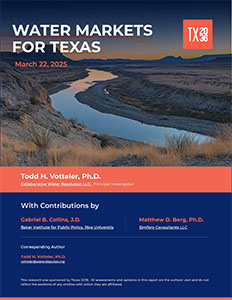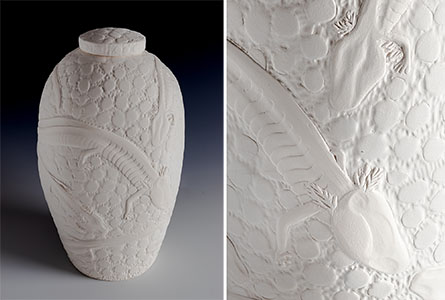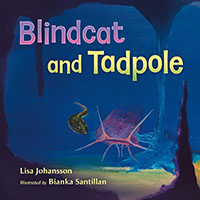
|
|
|
|
Votteler publishes new article on Water Markets for Texas On March 22, prolific Edwards Aquifer author Todd Votteler published a new article entitled Water Markets for Texas, a thorough and thoughtful analysis of the importance of water markets and barriers to their establishment. Longtime readers of these pages know that Mr. Votteler is particularly well qualified to author on this topic. He served as special master for the U.S. District Court in Midland in the Sierra Club v. San Antonio case, the famous lawsuit that resulted in the management of the Edwards Aquifer that is in place today. He also worked for the court monitor during Sierra Club v. Babbitt and has in-depth first hand knowledge of the many complicated legal, hydrologic, economic, and cultural issues surrounding the Edwards Aquifer and water issues in Texas. His previous articles have examined almost all aspects of water in Texas, including boondoggle water development schemes, drought, floods, and Texas water policy. I am pleased to be able to offer a selection of his publications for reading and downloading in The Todd Votteler Archives. Texas Blind Salamander included in art project to highlight endangered species In March, Montana artist and professor Julia Galloway was working on an ambitious project to raise awareness about endangered species by creating a ceramic urn to represent each of the approximately 1,200 species in the U.S. that are threatened, endangered, recovered, or extinct. I was very happy she was able to use my Texas Blind Salamander photo to create the urn below. TCEQ Office of Public Interest Counsel recommends denial of Guajalote Ranch permit In mid-March, the Office of Public Interest Counsel (OPIC), an independent office within TCEQ that is a party to all contested case hearings, recommended that TCEQ commissioners deny the Guajalote Ranch discharge permit. OPIC lawyers said "Upon consideration of all testimony regarding the proposed daily average effluent limit of 0.15 mg/L for total phosphorous, OPIC agrees with Protestant's contention that Applicant has failed to meet its burden to show that the draft permit is sufficiently protective of water quality." They also noted "Country streams like Helotes Creek should be maintained at 0.02 mg/L [of phosphorous] to maintain natural algae assemblages and to protect the most sensitive fish species." In making their final decision on the permit, TCEQ commissioners will consider all briefs and filings, including those from OPIC. |
|
Sale of land to Texas Parks and Wildlife will expand Government Canyon State Natural Area In February, a deal was closed for purchase by the Texas Parks and Wildlife Department of 823 acres that will expand the 12,000 acre Government Canyon State Natural Area. The land had been owned for generations by the McNeel family and the state agency paid $8 million to acquire it. James McNeel said he had many other offers to buy the land, but wanted more for the land than to be carved up and sold for development. He grew up here camping and trail running and knows the creek beds, cliffs, hilltops, farmlands, and forests well. He said "We got pretty interested in the idea that we could find a way to help the problem in the state of Texas of having very, very, very little publicly accessible or public land. So when the time came to start thinking about what to do with this property...and exciting opportunity just came up. My values and beliefs about the built environment and what makes human life actually worth living and helps people to actually flourish is deeply aligned with this attitude of making sure there's fair and equitable access to nature." Readers of these pages who have explored the deep story on Government Canyon will recall this area was the site of the first pitched battle over Edwards Aquifer protection in the early 1970s. The proposal was to develop 9,000 acres known as Ranch Town into homes for 88,000 people, and future San Antonio Mayor Phil Hardberger represented environmental interests in opposing it. They lost, but the economic downturn of the mid 1970s resulted in nothing much actually being built. About this time another future San Antonio Mayor Lila Cockrell suggested the best way to protect the Edwards might be just to buy sensitive tracts of land. It wasn't until 1993 that most of what would have been Ranch Town was purchased to become Government Canyon, and in 2000 voters first approved a sales tax to acquire other sensitive tracts of land for Aquifer protection. Hearing held on Guajalote Ranch discharge permit During the last week of February, judges from the State Office of Administrative Hearings held a three-day hearing regarding the proposed wastewater discharge permit for Guajalote Ranch. Opponents continued to argue that wastewater from the plant would harm wildlife and water quality, including both nearby wells and parts of the Trinity and Edwards aquifers. TCEQ's review of the draft permit determined that "existing water quality uses will not be impaired by this permit action" and that "existing uses will be maintained and protected." Troy Hotchkiss, an engineer who worked on the permit application, filed testimony before the hearing and said the plant would use "the most advanced wastewater treatment currently available" and would "achieve the highest levels of domestic wastewater treatment commonly achievable." Hydrologist and geologist Ron Green testified on behalf of the opponents and said the discharge area sits above the Trinity Aquifer and Edwards Aquifer Contributing Zone, and there are geologic faults in the discharge route that "could provide conduits for the flow of contaminants into the groundwater." After the hearing, parties were scheduled to file closing briefs by March 11 and responses to brief by March 21. A proposal for decision from the judges was expected by May 20, and then the matter returns to TCEQ for a final decision. Company fined for building in Recharge Zone without permit On February 27, TCEQ commissioners were scheduled to consider an agreed order that would assess a penalty of $20,000 against NPC Braunfels LLC, which allegedly began construction on a project in the Recharge Zone without required permits and protection plans. TCEQ sent an investigator to the site in May 2023 in response to citizen complaints and documented a two-story house, more than 15 building pad sites, and other facilities. TCEQ alleged that violations included failure to obtain approval of an Edwards Aquifer protection plan and failure to obtain a necessary stormwater permit. The agreed order called for a total penalty of $20,000 but $4,000 would be waived if the company fully complied with the order. The order said that NPC Braunfels had already paid the remaining $16,000. |
|
Author Lisa Johansson releases Blindcat and Tadpole In January 2025, author Lisa Johansson released a wonderful new children's book, Blindcat and Tadpole, which highlights the Mexican Blindcat, an interesting and endangered species, while exploring aquifer systems and the diversity of life they host. It is available on Amazon. City Council hears update on Edwards Aquifer Protection Program On January 15, Grant Ellis, Natural Resources Manager for the San Antonio Parks and Recreation Department, offered City Council an update on the Edwards Aquifer Protection Program, a program first initiated by voters in May 2000 to purchase tracts of land or conservation easements for Edwards protection. After summarizing the background of the program, Ellis detailed how a Scientific Evaluation Team identifies potential land for conservation, ranking properties based on water resources, biology, property size, and location. He then described the acquisition approach, which can include fee simple ownership or conservation easements, and noted that 95% of property interests acquired so far are conservation easements. He also noted that all properties are monitored annually by City of San Antonio and Edwards Aquifer Authority staff. Ellis also noted that some purchased properties have been able to be used in other ways in addition to Aquifer protection. For example, purchased properties were added to the Government Canyon State Natural Area and most of the Classen-Steubing Ranch Park was acquired using Aquifer protection dollars. Ellis said that so far, 187,343 acres of land have been protected through the Program. In 2025, using $10 million adopted in the city's budget, the Program will continue to target properties in sensitive recharge and contributing zones, and also work to connect existing protected lands. |


